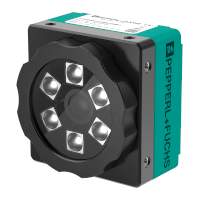Optical Identification in Battery Production with VOS-I Universal Code Reader
Vision Sensor with Multi-Code Reading Ensures Comprehensive Detection

The Application
In the production of larger batteries, individual battery cells are bundled together into one battery module. To achieve this, the battery cells move along a conveyor belt and are then separated. After separation, the movement of the conveyor belt causes the batteries to continue to rotate. The cells are provided with codes. The codes of all the separated batteries should now be read when the batteries are rotating. Individual identification of individual cells is important for quality assurance purposes and for ensuring traceability of the process steps. The finished module is placed in the battery frame by a robot. The module is likewise provided with a code to ensure that it can be correctly identified and assigned.
The Goal
It is essential that all required cells are actually present during bundling. To ensure this, multiple codes must be read simultaneously, often at high throughput and high process speeds. The codes are often very small and applied on curved surfaces. The code reader must therefore not only have a wide reading range but also be able to reliably detect very small codes at high resolutions. When reading the code on the finished battery module, it must be possible to detect the code even at large distances. Continuous communication must be guaranteed between the code reader and the controller and higher-level systems. When data is transferred directly to an ERP system, the data should ideally be formatted in such a way that no adaptation is required in the ERP system. If there is a read error when reading a code, an error image must be available and easy to retrieve.
The Solution

VOS-I Universal Code Reader
The VOS-I universal code reader can detect up to 64 codes simultaneously. Multi-code reading is reliable even when detecting very small codes at high throughput. Missing cells are detected immediately; the evaluation performed by the integrated script can also identify the missing cell and empty slot. Preliminary evaluation is also possible, which minimizes the effort on the control side. All the relevant interfaces are integrated in the device, and the format of the data output can also be adapted.
Technical Features
- Movement speeds of up to 4 m/s at up to 30 reads/s
- Wide selection of illumination and lenses
- Distances of up to 2 m
- Resolutions of up to 5.2 megapixels
- Flexible output string formatting and preliminary evaluation via script
- Interfaces: TCP/IP, PROFINET, EtherNet/IP, RS-232, and I/O
- Match code, multi-code, multi-window, and multi-sensor mode
The Benefits
The sensors in the VOS-I series can detect the code quality. They can therefore rule out read errors and emit a corresponding signal if the code quality is insufficient. Different sensor versions offer different resolutions of up to 5.2 megapixels. There are models with integrated illumination and lenses as well as versions that can be combined with external lighting and corresponding lenses via C-mount connection. This allows use in a wide variety of distance and detection ranges. The detection range can be extended further by arranging multiple sensors in a client/server network.
At a Glance
- Reliable reading of all common 1-D and 2-D codes, including DPM (laser-inscribed and dot peen)
- Parameterization and storage of up to 32 jobs on the sensor
- Multi-code reading of up to 64 codes in a single read, including automatic detection of code quality
- Wide selection of illumination and lenses
- All relevant interfaces are integrated, allowing for end-to-end communication all the way through to the ERP system
- Flexible formatting of the output string and preliminary evaluation via script










 +81 45 6249077
+81 45 6249077